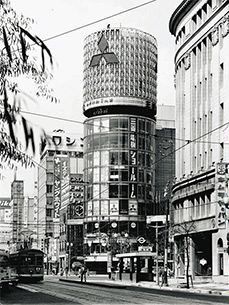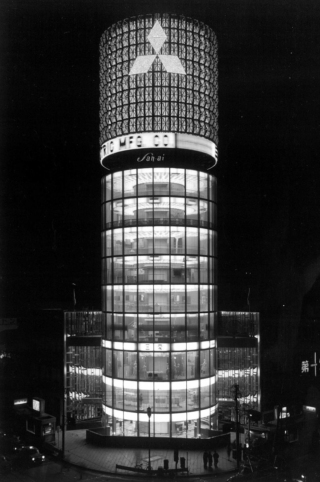Another famous Tokyo building with ties to Japan’s automotive history is on the chopping block. It was announced earlier this year that the San’ai Dream Center is scheduled to be demolished. For 60 years it has been a landmark in the heart of Ginza, Tokyo’s trend-setting shopping district packed with high-end stores. Companies such as Nissan, Mazda, and Mitsubishi once displayed their latest and greatest in the building’s distinctive glass cylinder, but those sweeping window will be no more.
 Like so many Japanese icons, the San’ai Dream Center was built just ahead of the 1964 Tokyo Olympics in order to prove to the world that Japan was a reformed, modern nation. It opened its doors in 1963 to serve as a symbol of the Ricoh San’ai Group, the same company that makes cameras and photocopiers.
Like so many Japanese icons, the San’ai Dream Center was built just ahead of the 1964 Tokyo Olympics in order to prove to the world that Japan was a reformed, modern nation. It opened its doors in 1963 to serve as a symbol of the Ricoh San’ai Group, the same company that makes cameras and photocopiers.
In a manner typical of large Japanese manufacturing concerns, however, the branding was centered on the San’ai division, a brand of women’s clothing. It made sense for the building to be situated at the 4-chome intersection of Chuo-dori and Harumi-dori, two major streets in Tokyo, where the high-end Wako and Mitsukoshi department stores and nearby fashion hotspots were located.
Designed by famed Japanese architecture firm Nikken Sekkei and overseen by renowned architect Shoji Hayashi, the San’ai Dream Center consisted of a cylindrical shaft in the center, which supported each of the nine disc-shaped stories and three basement levels. Floors were built on ground level around the shaft, then slid upward into place like an upside-down ring toss. The unconventional method received considerable attention and television coverage during its construction. Due to fire codes, the 250 sheets of curved glass required wire reinforcements and Shinko, the company that made them, still proudly touts their contributions to the San’ai Dream Center.
 At midnight on January 13, 1963, an opening ceremony inaugurated the building. Ricoh founder Kiyoshi Ichimura flipped on the lights while a platform with actor and musician Frankie Sakai appeared on the ground floor. As the platform was hoisted upward with Sakai drumming along, each story of the building lit up, its bright lights beaming across the Ginza nightscape. As Sakai reached the top a giant red Mitsubishi triple-diamond logo blazed into existence.
At midnight on January 13, 1963, an opening ceremony inaugurated the building. Ricoh founder Kiyoshi Ichimura flipped on the lights while a platform with actor and musician Frankie Sakai appeared on the ground floor. As the platform was hoisted upward with Sakai drumming along, each story of the building lit up, its bright lights beaming across the Ginza nightscape. As Sakai reached the top a giant red Mitsubishi triple-diamond logo blazed into existence.
The logo wasn’t there to hawk Minicas and Debonairs, though. Floors four through nine of the San’ai Dream Center were initially devoted to an electronics showroom called the Mitsubishi Electric Sky Ring. However, it was still car-adjacent as the main products on display hailed from Mitsubishi Electric’s Diatone line of audio equipment, which grew to include car stereos and the world’s first in-car GPS system that appeared on Mazda’s 1990 Eunos Cosmo.
The Mitsubishi logo illuminated Ginza for almost three decades until it was taken down in May 1990. It was such a fixture in Tokyo that many locals simply called the San’ai Dream Center the “Mitsubishi Building”. Down the street, where companies like Fujiya, Toyota and Enicar had major advertising presences, the Mitsubishi logo on the San’ai building could still be seen lurking in the background. Other major companies have since occupied the top spot – Coca-Cola, Suntory Whisky, Vodafone — but it wasn’t until 2014 that Ricoh put its own name on the building it erected. Each of four times the sponsor has changed, it was deemed a newsworthy event by the press.
Nissan was an early tenant, using the second story of the San’ai Dream Center as the site of the original Nissan Gallery. The old Nissan headquarters before they moved to Yokohama was just a few blocks away and often had displays in and in front of the building. But there was nothing like showcasing Bluebirds and Fairlady roadsters on the prime real estate at Ginza 4-chome.
Nissan staffed the gallery with saleswomen called Miss Fairladys. It was the perfect place to chat about Nissan’s latest offerings or pick up a Cedric brochure. When a Genichiro Tahara won the B-II class at the inaugural Japan Grand Prix in May 1963 with a Fairlady 1500, his No.39 car was displayed in front of the gallery for all to see.
Rotating the displays wasn’t easy. Cars had to be loaded into the second story gallery via a crane, and once inside there was surprisingly little room for people to maneuver around them. By April 1970, the Nissan Gallery had relocated to the Ginza Sapporo (as in the beer) building across the street, where it is still located today.
That left the second floor of the San’ai Dream Center open for another automotive showroom. It’s not clear how long Mazda held the spot, but around 1970-71 the space was being used to display the brand new Capella Rotary Coupé and Capella Rotary 4-door DX (aka Mazda RX-2) and their newfangled rotary engines.
On January 31, the final tenants of the San’ai Dream Center vacated, and on February 1 Ricoh issued a press release stating that the building would begin demolition in March. The company said that after 60 years, the building had aged to the point where it needed to be rebuilt.
It’s a sad end for a landmark structure, but the one consistent thing about Tokyo is that it’s always changing. It’s one of 268 historically significant examples of modern architecture selected by Docomomo International, a non-profit dedicated to conserving buildings. But like Toyota’s Megaweb showroom, the Nakagin Capsule Tower, and Shinjuku’s Subaru Building, something new will spring up in its place looking right at home and people will forget what was there to begin with. The San’ai Dream Center’s replacement, described by Ricoh as “a new landmark that is uniquely Ricoh and suitable for the town of Ginza,” is scheduled to open in 2027.
Images: Ricoh, Nissan, tansaisuketti














Although I didn’t get to spend much time to admire the Mitsu building during our visit to Tokyo, this post made me somehow “miss” the building and its history. But with anything, you have to constantly evolve in order to keep up, if not stay ahead of the times and trends / regulations.
Japan definitely knows how and where to retain its historical heritage, like up in the Hakone mountains, where the majority of the businesses still only accept cash. But as you get into the metropolitan, all the crazy architecture and technology just fills up the eyes. The Megaweb definitely looked pretty modern when we went in 2018, but I’m pretty optimistic that its replacement, as well as the San’ai’s replacement will be equally mind-blowing.
Japan… very interesting about their mentality on many topics.
I wish I could have seen this back when it was automotive related. I’m still gutted about the Toyota WEB.